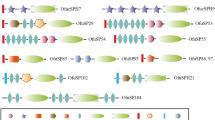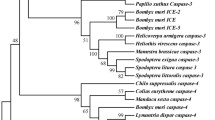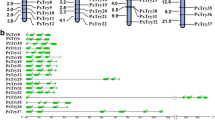Abstract
Tetrahydrobiopterin (BH4) is an essential cofactor for aromatic acid hydroxylases and nitric oxide synthase. Sepiapterin reductase (SPR) catalyzes the final steps of BH4 biosynthesis. Studies on SPR from several insects and other organisms have been reported. However, thus far, enzyme activity of SPR in Musca domestica is kept unknown. In this study, 186 differentially expressed genes including SPR gene from Musca domestica (MDSPR) were screened in subtractive cDNA library. The MDSPR gene was cloned, and the recombinant MDSPI16 protein was expressed as a 51-kDa protein in soluble form. The MDSPR exhibited strong activity to the substrate sepiapterin (SP). The values of Vmax and Km of the MDSPR for SP were 6.83 μM/min and 23.48 μM, and the optimum temperature and pH of MDSPR were 50 °C and 4.0, respectively. This study provides new hypotheses and methods for the production of BH4 using insect-derived SPR.





Similar content being viewed by others
References
Thöny, B., Leimbacher, W., Blau, N., Harvie, A., & Heizmann, C. W. (1994). Hyperphenylalaninemia due to defects in tetrahydrobiopterin metabolism: molecular characterization of mutations in 6-pyruvoyl-tetrahydropterin synthase. American Journal of Human Genetics, 54, 782–792.
Werner-Felmayer, G., Golderer, G., & Werner, E. R. (2002). Tetrahydrobiopterin biosynthesis, utilization and pharmacological effects. Current Drug Metabolism, 3, 159–173.
Meng, Y., Katsuma, S., Daimon, T., Banno, Y., Uchino, K., Sezutsu, H., Tamura, T., Mita, K., & Shimada, T. (2009). The silkworm mutant lemon (lemon lethal) is a potential insect model for human sepiapterin reductase deficiency. Journal of Biological Chemistry, 284, 11698–11705.
Kaufman, S. (1993). New tetrahydrobiopterin-dependent systems. Annual Review of Nutrition, 13, 261–286.
Thöny, B., Auerbach, G., & Blau, N. (2000). Tetrahydrobiopterin biosynthesis, regeneration and functions. Biochemical Journal, 347(pt 1), 1–16.
Sharma, M., Maraganore, D. M., & Ioannidis, J. P. A. (2011). Role of sepiapterin reductase gene at the PARK3 locus in Parkinson’s disease. Neurobiology of Aging, 32 , e1–e5.2108
Ichinose, H., Katoh, S., Sueoka, T., Titani, K., Fujita, K., & Nagatsu, T. (1991). Cloning and sequencing of cDNA encoding human sepiapterin reductase-an enzyme involved in tetrahydrobiopterin biosynthesis. Biochemical and Biophysical Research Communications, 179, 183–189.
Citron, B. A., Milstien, S., Gutierrez, J. C., Levine, R. A., Yanak, B. L., & Kaufman, S. (1990). Isolation and expression of rat liver sepiapterin reductase cDNA. Proceedings of the National Academy of Sciences, 87(16), 6436–6440.
Ota, A., Ichinose, H., & Nagatsu, T. (1995). Mouse sepiapterin reductase: an enzyme involved in the final step of tetrahydrobiopterin biosynthesis. Primary structure deduced from the cDNA sequence. Biochimica et Biophysica Acta (BBA) – Gene Structure and Expression, 1260, 320–322.
Kim, K., Song, K. H., & Yim, J. (2015). A comparative structural analysis of sepiapterin reductase from drosophila by homology modeling. Pteridines, 26, 55–61.
Katoh, S. (1971). Sepiapterin reductase from horse liver: purification and properties of the enzyme. Archives of Biochemistry and Biophysics, 146, 202–214.
Lineweaver, H., & Burk, D. (1934). The determination of enzyme dissociation constants. Journal of the American Chemical Society, 56, 658–666.
Watschinger, K., Keller, M. A., McNeill, E., Alam, M. T., Lai, S., Sailer, S., Channon, K. M., & Werner, E. R. (2015). Tetrahydrobiopterin and alkylglycerol monooxygenase substantially alter the murine macrophage lipidome. Proceedings of the National Academy of Sciences of the United States of America, 112(8).
Watschinger, K., Keller, M. A., Hermetter, A., Golderer, G., Werner, F. G., & Werner, E. R. (2009). Glyceryl ether monooxygenase resembles aromatic amino acid hydroxylases in metal ion and tetrahydrobiopterin dependence. Biological Chemistry, 390, 3–10.
Werner, E. R., Blau, N., & Thöny, B. (2011). Tetrahydrobiopterin: biochemistry and pathophysiology. Biochemical Journal, 438, 397–414.
Dhillon, B., Badiwala, M. V., Maitland, A., Rao, V., Li, S. H., & Verma, S. (2003). Tetrahydrobiopterin attenuates homocysteine induced endothelial dysfunction. Molecular and Cellular Biochemistry, 247, 223–227.
Higashi, Y., Sasaki, S., Nakagawa, K., Fukuda, Y., Matsuura, H., Oshima, T., & Chayama, K. (2002). Tetrahydrobiopterin enhances forearm vascular response to acetylcholine in both normotensive and hypertensive individuals. American Journal of Hypertension, 15, 326–332.
Wang, W., Gao, J., Wang, J., Liu, C., & Meng, Y. (2012). Cloning, expression and enzymatic properties analysis of dihydrofolate reductase gene from the silkworm, Bombyx mori. Molecular Biology Reports, 39, 10285–10291.
Yoon, K. H., Cha, K. W., Park, S. I., & Yim, J. J. (2013). Isolation and characterization of sepiapterin reductase from Drosophila melanogaster. Pteridines, 4, 43–50.
Yamamoto, K., Kataoka, E., Miyamoto, N., Furukawa, K., Ohsuye, K., & Yabuta, M. (2003). Genetic engineering of Escherichia coli for production of tetrahydrobiopterin. Metabolic Engineering, 5, 246–254.
Thöny, B., Leimbacher, W., Bürgisser, D., & Heizmann, C. W. (1992). Human 6-pyruvoyltetrahydropterin synthase: cDNA cloning and heterologous expression of the recombinant enzyme. Biochemical and Biophysical Research Communications, 189(3), 1437–1443.
Yang, S., Jan, Y. H., Gray, J. P., Mishin, V., Heck, D. E., Laskin, D. L., & Laskin, J. D. (2013). Sepiapterin reductase mediates chemical redox cycling in lung epithelial cells. Journal of Biological Chemistry, 288, 19221–19237.
Sueoka, T., & Katoh, S. (1985). Carbonyl reductase activity of sepiapterin reductase from rat erythrocytes. Biochimica et Biophysica Acta, 843, 193–198.
Ruiz-Vázquez, P., Silva, F. J., & Ferré, J. (1996). Characterization of sepiapterin reductase activity from Drosophila melanogaster. Comparative Biochemistry and Physiology Part B Biochemistry and Molecular Biology, 113, 131–136.
Fujimoto, K., Takahashi, S. Y., & Katoh, S. (2002). Mutational analysis of sites in sepiapterin reductase phosphorylated by Ca2+ / calmodulin-dependent protein kinase II. Biochimica et Biophysica Acta, 1594, 191–198.
Author information
Authors and Affiliations
Corresponding author
Additional information
Yan Tang and Zhihua Pei contributed equally to this work and should be considered co-first authors.
Rights and permissions
About this article
Cite this article
Tang, Y., Pei, Z., Liu, L. et al. Expression and Enzyme Activity Detection of a Sepiapterin Reductase Gene from Musca domestica Larva. Appl Biochem Biotechnol 181, 604–612 (2017). https://doi.org/10.1007/s12010-016-2235-0
Received:
Accepted:
Published:
Issue Date:
DOI: https://doi.org/10.1007/s12010-016-2235-0




